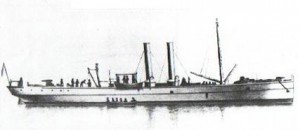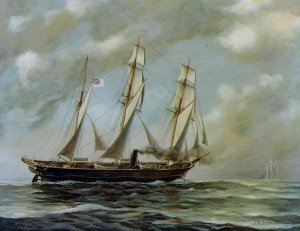
The American Civil War battles were waged all over the south, in the far west in the present state of Arizona and in the north at Gettysburg. One of the somewhat under publicized actions undertaken by the Confederate Navy were hostile events in the Atlantic as far north as Nova Scotia. Not only did significant action occur in the North Atlantic but damage to Union shipping was widespread. The navy in the Civil War was very active in the North Atlantic.
The CSS Tallahassee
This story’s focus is on the Confederate Navy’s ironclad coal powered steamer CSS Tallahassee and the nineteen days of raids during 1864. The Confederates named the ship after the Florida state capital. Interestingly enough, the CSS Tallahassee was able to obtain coal at Halifax. Neutrality laws applied to Nova Scotia but part of those laws required that a Civil War ship could only remain there 24 hours.The Tallahassee was originally named the Atalanta and had bee built on the Thames River in England. She was a fast vessel and very stable. With her twin screws, the Talllahassee was said to be able to cross the English Channel in 77 minutes. After the ship successfully ran the Union blockade in Wilmington several times, the Confederacy purchase her in 1864.

The CSS Tallahassee was successful in running the Union blockade at Wilmington North Carolina on August 6th and steamed northward. The Confederate steamer was described as about one thousand tons, painted a light lead color, no bowsprit, with two smoke-stacks and a red bottom. The Commander of the CSS Tallahassee was John Taylor Wood. Wood was a relative of Jefferson Davis and a grandson of President Zachary Taylor.
The CSS Tallahassee at War
After running the Union blockade on August 6th 1864, the CSS Tallahassee under the command John Taylor Wood went on a nineteen day spree of raids along the North Atlantic seaboard. The Tallahassee was responsible for the destruction of twenty-six ships. This Confederate Navy vessel had great success finding ways to steam through the blockades.
These raids on shipping were not lost on the Union Navy. In fact, the CSS Tallahassee had two Union gunboats on her tail as she sailed northward toward Halifax Nova Scotia. When the Tallahassee entered Halifax Harbor, Wood believed that the Union war ships anchored in the sea lane just outside the port. Commander Wood was well aware that he could be in a tight situation. While in port, the Confederate vessel loaded enough coal to make it to the nearest Confederate port and did repair work to her mast. The Tallahassee skipper met with luck. After spending some thirty-six hours at Halifax because of the mast repair, Commander Wood hired at local harbor pilot to guide him past the waiting federal vessels. This, the pilot did by using another more shallow channel generally used by fishing boats. The CSS Tallahassee reached the open sea and made her way back to Wilmington North Carolina.

As it turned out, there were no federal war ships waiting to intercept the Tallahassee. The first federal vessel that did arrive on the scene at the harbor entrance was the USS Pontoosuc which got there a few hours after the Tallahassee departed.
The Ship that Wouldn’t be Caught
Not only did the CSS Talahassee have a successful raiding run in the northeast in August of 1864 and then return safely to Wilmington from Halifax, but this well commanded Confederate Navy vessel continued to be very active in the Confederate war effort. The vessel took on a new name, the Olustee, and was put in command of Lt. W.H. Wood.
Again, the Olustee was successful in running the Union blockades. During the last part of October 1864 she ran a blockade and destroyed six ships off Cape Delaware. This time she did suffered damage while exchanging gunfire with federal war ships, nevertheless the Olustee did make it safely back to Wilmington.
Three additional Trips Into History articles and photos you’ll be interested in are the Jeremiah O’Brien Liberty Ship in San Francisco,…Piracy on the Ohio and Mississippi Rivers. and a Visit to the World War Two Submarine USS Pampanito.
A New Name and the Final Confederate Voyage
For a third time, the vessel received a new name by it’s Confederate owners. When the Olustee arrived back at Wilmington after the Cape Delaware action, the Confederacy changed her name to the Chameleon and removed her battery. Her new commander was Lt. J. Wilkinson. In late December 1846, the new Chameleon steamed toward Bermuda. Her mission was to obtain badly needed supplies and return to Wilmington.

The problem was that when the Chameleon tried to enter Wilmington or any other southern port she found it impossible. Commander Wilkinson decided to steam in the other direction and took the ship all the way across the Atlantic to Liverpool England.
The Chameleon arrived in Liverpool on April 9th 1864. The American Civil War was essentially over. The British seized the Chameleon and sold her to the merchant shipping fleet. Interestingly enough, the United States Government filed suit to have the vessel returned. After about one year, the Chameleon (aka Tallahassee and Olustee) was returned to the American consul in Liverpool and the U.S. government took ownership of the ship.
The CSS Tallahassee and History
There are several things that make the story of the CSS Tallahassee a significant American Civil War event. As mentioned at the beginning of this article, the danger to Union shipping in the Atlantic off New England by the Confederate Navy has not been an overly publicized element of Civil War history. This alone is significant. The fact that the then named CSS Tallahassee was able to raid for nineteen days and while being chased by federal war ships was able to find shelter in Halifax Harbor is another fascinating story. Add to this the fact she escaped from Halifax and safely steamed back to Wilmington is another unbelievable twist. In addition to all of the above, this same vessel under other names and other commands was able to continue running blockades and sink more Union vessels later the very same year.
The only real end to the story of the CSS Tallahassee was when she sailed to England in April of 1865 and effectively surrendered to the British government. In many ways, this vessel ended her wartime service to the Confederacy under her own terms, not by fire from a Union war ship.
Two good books on the subject of the Civil War navies are Blue and Gray Navies:The Civil War Afloat, by author Spencer Tucker and the book The Civil War at Sea, by author Craig Symonds.
(Photos are from the public domain)
